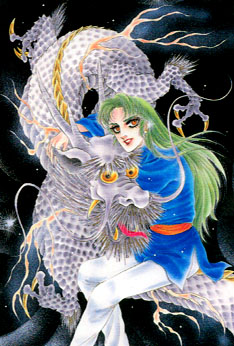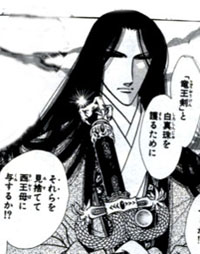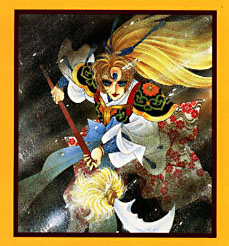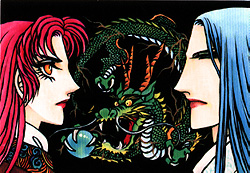

Reviewed by Jeanne
It began with Seishinja sending me umpty-million (meaning eight) large boxes of manga from her Manga Bonbons collection. One box was stuff I'd asked for. Seven boxes was stuff she'd decided I should read. None of it was shounen, naturally, but after that it was all over the map, from the most innocent of shoujo to the hardest of S&M; BL. I sat in my increasingly impassable front hallway taking out handfuls of manga and doing a fast sheep and goats sort on the basis of style and apparent content. At the end of the day the sheep pile was full of classic shoujo and shounen ai, and the goats pile was full of BeBoy Gold and Reijin. Classic stuff just looks better: better drawn, more intriguing, and for sure hotter.
This is something that western manga readers (as opposed to western picture readers) tend to say more frequently the more we read. The BL stuff is like fast food or potato chips. It doesn't fill you up. If you want a full course meal, you have to go back to the shoujo and tanbi masters (uhh- mistresses?)
As in: one of the greatest shoujo series of all times is YAMAGISHI Ryouko's Hi Izuru Tokoro no Tenshi. And if you think *that's* a mouthful, the English is worse: King's Son from the Land of the Rising Sun. The title's a reference to a famous piece of diplomatic condescension that happened back in the 7th century. Shotoku Taishi, the great statesman who promulgated the first Japanese constitution, sent a letter from his emperor (who was a woman, FWIW) to the emperor of the ancient and venerable, even in those days, land of China: 'from the prince of the land of the rising sun to the king of the land where the sun sets.' Parvenu snottery doesn't get much better than that.
Shotoku Taishi is much revered in Japan, and the story about his birth has intriguing parallels to the Christ story. He was called Umayado in life, meaning stable door, because guess what he was born in a stable (just outside a stable, actually- by the doorway) to the accompaniment of Buddhist choirs of angels. That notwithstanding, when Yamagishi came to draw a manga about him she turned him into a beautiful amoral sinister and fascinating bishounen. (In the proper definition of the term: he's ten when the series starts, eleven when he accomplishes his first proxy murder, and not yet twenty when the series ends.) Oh, and he suffers for love, and makes everyone else suffer too. Umayado is on everyone's list of Unforgettable Manga Characters- fascinating, bewitching, as repellant as he is sympathetic. Makes one wonder why the west thinks 'comicbook character' is a synonym for two-dimensionality.

Hi Izuru is a *great* manga. It's also a slog to read cause things were a lot different in the 7th century and the language reflects it. Start with the 'ko' ending being used on male names, continue with anyone who matters having about three different names and titles and you never being sure which is which, and end ohh probably with the realization that just about everybody in the series is married to their own sister 'cause see half-sibs by different mothers don't count as relations. Same mother of course merits the full incest taboo horrors, and gets them. All this is presented deadpan. It's a lovely fast trip into an utterly different mindset.
Well, and you finish Hi Izuru and wonder Now what can you do for an encore? Something long and multi-character, with attention paid to all the characters and not just the protagonists, good story, broad canvas, intricate plot, a look at a different culture and mindset... Oh, and a sense that the mangaka knows what she's doing. None of this AS or YnM or X 'following my nose vaguely in circles' until the series wanders off into the night and fails to come back. One doesn't want much, you know. Just another Tale of Genji when you've finished the first.

Luckily there would appear to be another Tale of Genji in manga. It's called Karin- Ring of Fire- and it's drawn by KAWASOU Masumi who did the long-running Touring Express. (The urge to write that as Kawaisou Masumi- 'poor Masuuumi'- is overwhelming, but I still resist. And spell-check.) I didn't know this when I first pulled Karin out of Seishinja's boxes. 'Classic shoujo' I said of the artstyle, and flipped to the back page: 'Copyright 1992?? Huhh?' Mh-hm. 1980's mangaka don't retire just because it's the 1990s and everyone has discovered BL.
Volume one was a rerun of Hi Izuru in certain ways. Primarily, 'the names dear god the names what's with the naaaames???' Taoist immortals is what's with the names, partly. Taoist Immortals have funny names. Deal, as a Chinese friend told me. Then there's Chinese readings of name kanji expressed in Chinese-unfriendly katakana, like the dragon king uhh Yao Kwan? Kuan? Kuang? (Harrumphs: *I* call him Goukou myself.)
But after that little adjustment we're in familiar Hi Izuru territory: there's this beautiful seductive bishounen (Rui, whatever that's meant to be, who does *not* have name kanji) with a supernatural aura to him who seems intent on spreading murder, mayhem and lust hither thither and yon. He instigates assassinations and political upheavals and large-scale wars, and he flourishes like the green bay tree except when he's Suffering For Love.  Opposite him there's an innocent and genki young hero (Liian, ditto about the name kanji), a bit more energetic than the rather wet Emishi who serves as foil to Umayado. Not that bishounen and genki-boi get together in this work. There's a little BL action but nothing like the m/f plotlines. Kawasou has no objections to m/m, as Touring Express demonstrates, but possibly out of deference to the Taoism that underlies this whole series, with its male-female dualism, male-female is what we get. So much so that several of the characters switch sex depending on who they've been near in the preceding days. Hang out too long with your long-lost Dad and presto, you have breasts! As for just how they're able to switch sexes-- well, that's one of many plot points you have to read the series to find out.
Opposite him there's an innocent and genki young hero (Liian, ditto about the name kanji), a bit more energetic than the rather wet Emishi who serves as foil to Umayado. Not that bishounen and genki-boi get together in this work. There's a little BL action but nothing like the m/f plotlines. Kawasou has no objections to m/m, as Touring Express demonstrates, but possibly out of deference to the Taoism that underlies this whole series, with its male-female dualism, male-female is what we get. So much so that several of the characters switch sex depending on who they've been near in the preceding days. Hang out too long with your long-lost Dad and presto, you have breasts! As for just how they're able to switch sexes-- well, that's one of many plot points you have to read the series to find out.
That's another thing I like about Karin. Switcheroos and stunning! revelations come about one per volume and sometimes twice. But equally, they're switcheroos that have been plotted well ahead of time and that make sense in the grand scheme of things. No following one's nose here. In contrast to the extended exercise of Touring Express (twenty-eight books produced over eighteen years) Karin's seventeen books were completed in a mere five. Three-plus tanks a year means she was drawing the series continuously, as she says in her afterword, and I must say that focusses a mangaka's attention wonderfully.

But besides these pluses is the bonus that Karin is a glorious mish-mash of everything Chinese you could wish for. The four Guardian Beasts, the Taoist Western Mother (and her daughter,) the Jade Emperor (and his son,) a trio of Pearl Spirits, and the Dragon Kings of the oceans. (King, actually- Yao Kuan the Blue Dragon of the Western Ocean is conflated with Seiryuu the dragon guardian of the west. He is also teh hot.) Politics on earth affect politics in Heaven, and Taoists and Celestials snark at each other cattily while insisting on their social prerogatives, and dispriz'd love causes trauma all round (including a little raping-uke action where *really* you'd least expect it) which gets settled by unexpected (no *really* unexpected) political marriages. And everyone wears gorgeous traditional court clothes.
The art style is yes classic shoujo manga. Hair down to here, on everybody. The eyes can get scarily enormous. Characters have an irritating tendency to (over)react to any piece of news with mouths wide open, bellowing "Nan da to!! (What did you say!!!) He's disappeared?? he's come back?? he's a woman??" But these are minor quibbles. The unlikely artwork is of a glorious piece with the unlikely action of the manga, by me. I highly recommend it to any Japanese, Korean or Chinese readers present.

Which only leaves the question of what you do when you've finished Karin. Why, then you go watch Twelve Kingdoms, evidently. Or read the novels if you can. Or both. Seems to me the only Chinese thing Karin *doesn't* have is kirin.